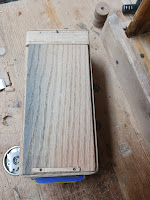Since I got a Miller's Falls #5 hand drill, I've been interested in eggbeater drills.
The MF #5 is smooooth and it doesn't break small bits like an electric. Maximum capacity is 1/4"
This is much as I found it for $3. I just wiped the sawdust off for the 1st time. Notice the sticker hasn't worn away.
It's almost as good as the restored ones by http://www.wktools.com
I picked up a #98 a few years ago.
It's a 2 speed. There's a knob to change speeds. Miller's Falls made these from 1913 - 1922.
I just started cleaning it up and I just need a crank handle.
The next one was a North Brothers "Yankee" breast drill.
I think this is the 1555 which was their largest.
Most breast drills are 2 speeds. They were used by mechanics for drilling metal.
In addition to 2 speeds, this has a ratchet and a forward direction only setting.
North Brother's Yankee line include the Yankee spiral screwdrivers, push drills and the finest brace ever made, the 2100. Eventually Stanley Tools aquired them and kept producing them.
Bell Systems issued the 2100 braces to its line workers, so you'll see then with Bell System stamped on them.
I have the range of screwdrivers, many push drills and a few of the braces and use them all the time.
I like to make nailed boxes with thin 1/4" wood so I need to predrill for the nails. The bits are under 1/16".
Hand drills are easier on the bits, but the #5 on the right is too big for the smaller bits.
Fiskars makes a plastic pistol grip drill that works nicely. I got one & used it for awhile until I found these smaller ones in the middle. They are not as smooth like the MF, but better than most modern hand drills.
The one on the left is a Goodell-Pratt. I think its a #53. It is like a smaller #5 and just as smooth. They made them from 1905 until MF bought them in 1930 and rebranded them.
Goodell-Pratt seemed to work closely with MF before the purchase. Their drills are every bit as good as the MF.This is an early MF. I think an 01.
The chuck is spring less but I'm missing the 3 upper jaws.
Because of this, I probably won't be able to get it running. Chuck parts are hard to find and a whole chuck will cost more than the $3 I paid for this. 😞
Maybe I'll get lucky and find another.
Instead of a 2nd gear, it has a screw that rides against the crank wheel to keep it in line.
A later method was to have a adjustable bent tab opposite the pinion gear.
Even later was a roller that was used on #2 before they added a 2nd gear to it.
This is my latest $3 purchase, #2A version of the legendary #2. They made the #2A from 1957-1968.
The chuck has a maximum capacity of 3/8". Better for larger bits than the #5. I think the #98 has a slightly larger chuck. The chuck mount is ~ 1/32" larger and not interchangeable.
Like my 01, this chuck isn't working either. I have all the parts, but one of the springs is broken. I am getting some 0.8mm spring steel to make my own.
I had a tough time opening up the chuck. I took a 2x4, cut a chuck sized hole, cut it in 1/2 and clamped it in my vice. I read lots of recommendations for a homemade pin spanner. I even bent a cheap commercial one. Not even a budge.
I put the chuck into a small container and filled it with Liquid Wrench to try to loosen it. While waited, I found https://madebyjohn.blogspot.com/2015/02/restoring-millers-falls-2-hand-drill.html used a Park Tools SPA-1 pin spanner for bikes so I bought one.
After a day or 2, I put the chuck back in the vice and used the spanner. It was tough and probably would have bent the other spanner, but the Park Tools one fit well and eventually the chuck started unscrewing.
Lots & lots of sawdust was inside. Now it's clean with a thin layer of oil and ready for me to make a spring.












































